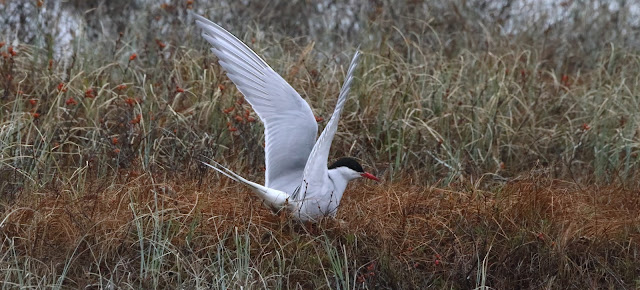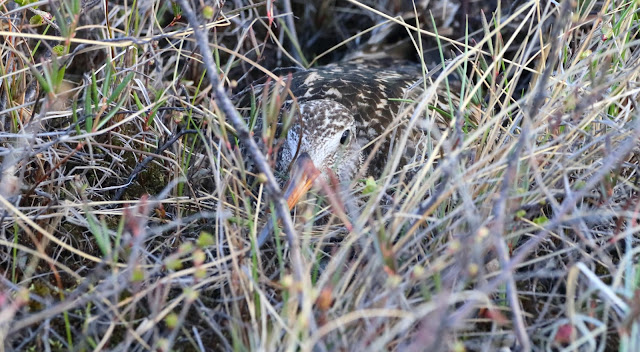adult male Hudsonian Godwit atop Black Spruce
ALASKA –HUDSONIAN GODWITS ON THEIR BREEDING HABITAT
15 – 27 May 2021
My main purpose for traveling to
Alaska was to spend time with Dr. Nathan Senner of the University of South
Carolina and his team as they studied nesting Hudsonian Godwits in the field.
Dr. Senner generously allowed me to shadow him and his team over a week as they
located active godwit nests in two large bogs in Beluga, Alaska, about 50 miles
due west of Anchorage, accessible by a bush plane flight of about 20 minutes.
I was able to drive to the two
bogs using a car on loan from the Beluga Fish Camp, where I was staying. The
Senner team was based in cabins situated between the two bogs, and drove to
them in two ATVs.
Dr. Senner was conducting an
abbreviated field tour because of the constraints of 2021 being a covid pandemic
year. He was accompanied in the field by a small team—a collaborating
scientist, Maria Stager, and a new graduate student, Lauren Puleo. The team’s
mandate was to find, trap, measure, and mark as many of the breeding godwits as
possible in a field season of less than a month. They also sampled insect
abundance to better understand foraging opportunities for the hatchling godwits
that grew up in the bog.
Senner had been working on
godwits in the Beluga area for more than a decade, and many of the birds in the
two bogs were well-known to him. Two years earlier, I had photographed an adult
Hudsonian Godwit in a boggy fen in Churchill, Manitoba, that Senner had color-marked
seven years before. Godwits apparently can live quite a while, and thus any
study that wants to get a grip on their life history would have to invest a
considerable number of years in the effort.
Here is the godwit life story in brief.
The adults arrive in southcentral Alaska in late April/early May. Male-female
pairs of godwits construct a grassy nest on a small hummock above the
waterline. The birds mate and the female lays four speckled green eggs in the
nest. The female sits on the nest during the daytime and the male occupies the
nest for the night (though there is not much true night up here in May and
June).
The eggs hatch after 27 days and
the precocial young are out and about exploring the world and feeding
themselves, carefully watched by the parents, from day-one of hatching. By early
July the parents start their journey southward, heading off to the saline lakes
of Saskatchewan, where they feed and build fat reserves for their long flight
to South America. The travel south and east to New England, from which they
launch out over the Atlantic, flying as much as 6 days nonstop before touching
down in northern South America (some birds stop in New England, others fly
nonstop from Saskatchewan to South America). The first-year birds do more or
less the same thing, on their own, and how they manage the long journey remains
a mystery. Most of the wintering birds (adults and young) end up in the Chiloe
Archipelago of southern Chile, where they spend as many as seven months of their
year. In March/April, the godwits move northward on a different track, crossing
the eastern Pacific and then Central America and then the Gulf of Mexico to the
US. After a rest and feeding in the Great Plains (where I have encountered them
in 2019 and 2020), they travel up to Canada and then westward and northward back
to Alaska.
One objective of my godwit
studies has been to visit three of the breeding zones of the species. I visited
Churchill, Manitoba, in 2019. Now Beluga, AK, in 2021. I hope to visit the
Mackenzie Delta of the Northwest Territories of Canada in June-July 2022. My
travels to the Mackenzie Delta have been prevented, of late, by the covid
pandemic and Canadian travel restrictions.
The two large Beluga bogs, north
and south, both hosted nesting godwits. Finding the godwits was not terribly
difficult, but finding nests is. To do so, the team would systematically walk
sectors hoping to flush a bird off an active nest. The sitting bird rarely
flushed until the walker was within 5 feet of the nest. It was theoretically
possible to spot a bird on the nest before flushing it, but that was especially
difficult to accomplish.
The bogs supported other nesting
waterbirds: Arctic Terns, Mew Gulls, Bonaparte’s Gulls, Red-necked Phalaropes,
Least Sandpipers, Wilson’s Snipes, Short-billed Dowitchers, Sandhill Cranes,
Pintails, White-fronted Geese, and more. But it was remarkable how difficult it
was for a mortal like me to come upon the hidden nests of many of these birds.
The nests of the terns and gulls were easy to find, but the others were well
hidden.
To a field naturalist, the bog
environment is seductive. It is open, with stunning vistas of nearby Sleeping Lady as well as the snowy mountains
of the Alaska Range. It is a mix of open water, wet grasslands, quaking
boglands, and stands of Black Spruce. This time of year, cow Moose hide in the
Black Spruce thickets and drop their calves. Inadvertently flushing a cow Moose
from a thicket is an experience that gets one’s attention quickly, as this seven-foot-tall
beast bursts out of the spruces. Is the great beast coming for you or avoiding
you? Sometimes that is not immediately clear.
I carried bear spray on my hip
whenever I was out and about in Alaska. This is protection for Moose and bear.
David Sonneborn reported to me that he had successfully deflected the charge of
a cow Moose, though I cannot imagine the experience being anything besides
hair-raising.
The more commonplace threat in
the bog is biting insects. The mosquitoes are the major problem. Luckily for
us, they do not appear in swarms until the 1st of June. In my last
few days in Beluga, I found more and more mosquitoes in the woods, but I
escaped back home before they became unpleasant.
Once the Senner team located a
nest, they marked its location by placing a small dead branch in the grass. Even
with the branch in place, and the adult on the eggs, it was very difficult to
locate the nest again.
The team captured both sitting
adults using a mist-net that was gently laid down over the nest and sitting
bird. Most birds were already marked birds known to Senner. Each trapped bird
was “processed”—weighed, measured, and its tiny geolocator replaced (the old
one for downloading, the new one for recording its movements over the next
year).
The recovered geolocator allowed
Senner to map a year’s worth of movements by the bird. The advantages of using
geolocators as opposed to satellite transmitters are several: light weight, low
expense, and low impact on the bird. The two disadvantages are that the results
are not quite as precise and one is forced to recapture the bird to recover the
data.
The godwit’s day is pretty well
set. The male would feed all day out on the mudflats of Cook Inlet. He then would
return around 6pm to the bog and swap places with the female. The female would
forage and loaf through the evening and night and return the next morning
around 6 am.
I did manage to see godwits on
virtually every visit I made to the bogs. Birds typically made a racket on
their return to the bog, and they would often perch atop Black Spruces and eye
us suspiciously. Sometimes they would circle the bog high overhead vocalizing.
They rarely gave us much indication as to where their nests might be...
Tromping the bogs was great fun
and also great exercise. I loved hearing the godwits and I was not terribly
annoyed by the dive-bombing Bonaparte’s Gulls and Arctic Terns. Neither ever
struck me, but they came very close indeed.
The Senner team put in long, long
days in the bogs. Their efforts paid off—locating more than a dozen nests and
marking more than twenty adults. I, myself, could not keep up there pace, but
it was a great privilege being able to spend time out there with them as they
did their work. I salute what they are doing!
nesting Bonaparte's Gull























No comments:
Post a Comment